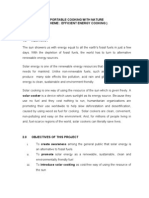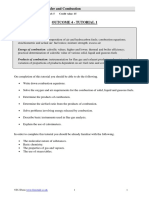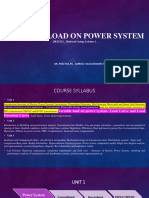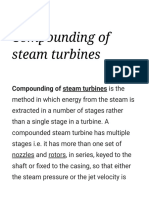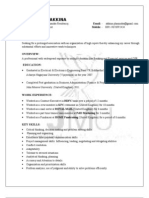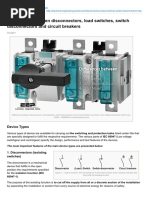Lecture 1 - Rankine Power Cycles
Lecture 1 - Rankine Power Cycles
Uploaded by
Muhammad Alam Zaib KhanCopyright:
Available Formats
Lecture 1 - Rankine Power Cycles
Lecture 1 - Rankine Power Cycles
Uploaded by
Muhammad Alam Zaib KhanCopyright
Available Formats
Share this document
Did you find this document useful?
Is this content inappropriate?
Copyright:
Available Formats
Lecture 1 - Rankine Power Cycles
Lecture 1 - Rankine Power Cycles
Uploaded by
Muhammad Alam Zaib KhanCopyright:
Available Formats
Page 1 of 5 Lecture 1
Lecture 1: Rankine Power Cycles
Power Generation Vapor Power Systems
The Rankine cycle is the basic building block of the vapor power plants. The component of the power plant is shown in the Figure 1.1. The whole plant is broken into four major subsystems from A D. Our main concern in these lectures will be subsystem B, where the conversion of heat into work occurs. The other subsystems will be discussed in later lectures.
The Ideal Rankine Power Cycle
Rankine Cycle is a vapor-and-liquid cycle, and accepted as the standard for steam power plants. Rankine cycle will be studied in its simplest ideal form to its more complex non-ideal form with modifications and additions that render it one of the most efficient means of generating electricity
Figure 1.1: (a) Rankine power cycle with two-phase working fluid (b) T s diagram of Rankine cycle [Moran and Shapiro, Fundamentals of Engineering Thermodynamics]
Page 2 of 5 Lecture 1 A schematic of the components of a Rankine cycle is shown in Figure 1.1(a). The cycle is shown on P v, T s and h s coordinates in Figure 1.1(b) and 1.2. The internally reversible processes in the Rankine cycle are as follows: Process 1 2: Isentropic expansion of the working fluid through a turbine from saturated vapor at state 1 to the condenser pressure. The quality decreases from unity Process 2 3: Heat transfer from the working fluid as it flows at constant pressure through the condenser with saturated liquid at state 3. Process 3 4: Isentropic compression in the pump to state 4 in the compressed liquid region. Process 4 1: Heat transfer to the working fluid as it flows at constant pressure through the boiler to complete the cycle. The ideal Rankine cycle also includes the possibility of superheating the vapor, as in cycle 1' 2' 3 4' 1'. The importance of superheating is discussed later.
[P v coordinates] [T s coordinates] [h s coordinates] Figure 1.2: Rankine cycle diagram. Stations correspond to those in Figure 1.1 In the Rankine cycle, the mean temperature at which heat is supplied is less than the maximum temperature, T2, so that the efficiency is less than that of a Carnot cycle working between the same maximum and minimum temperatures. The heat absorption takes place at constant pressure over eab, but only the part ab is isothermal. The heat rejected occurs over cd; this is at both constant temperature and pressure.
Performance Parameters
The thermal efficiency gauges the extent to which the energy input to the working fluid passing through the boiler is converted to the net work output. Using the enthalpies, heat and work quantities and expressions, the thermal efficiency of the power cycle is; The net work output equals the net heat input. Thus, the thermal efficiency can be expressed alternatively as; ( ) ( ) The heat rate is the amount of energy added by heat transfer to the cycle, usually in Btu, to produce a unit of net work output, usually in kW.h. Accordingly, the heat rate, which is inversely ( ) ( )
Page 3 of 5 Lecture 1 proportional to the thermal efficiency, has unit of Btu/kW.h. Another parameter used to describe power plant performance is the back work ratio, or bwr, defined as the ratio of the pump work input to the work developed by the turbine, it is written as; ( )
There are several features that should be noted about Figure 1.2 and the Rankine cycle in general: 1. The T s and the h s diagrams are not similar in shape, as they were with the perfect gas with constant specific heats. The slope of a constant pressure reversible heat addition line is,( ) . In the two-phase region, constant pressure means also constant
temperature, so the slope of the constant pressure heat addition line is constant and the line is straight. 2. The effect of irreversibilities is represented by the dashed line from b to c'. Irreversible behavior during the expansion results in a value of entropy sc' at the end state of the c' expansion that is higher than sc. The enthalpy at the end of the expansion (the turbine exit) is thus higher for the irreversible process than for the reversible process, and, as seen for the Brayton cycle, the turbine work is thus lower in the irreversible case. 3. The Rankine cycle is less efficient than the Carnot cycle for given maximum and minimum temperatures, but, as said earlier, it is more effective as a practical power production device.
Enhancements of, and Effect of Design Parameters on, Rankine Cycles
The basic Rankine cycle can be enhanced through processes such as superheating and reheat. Diagrams for a Rankine cycle with superheating are given in Figure 1.3. The heat addition is continued past the point of vapor saturation, in other words the vapor is heated so that its temperature is higher than the saturation temperature associated with Pa (= Pb = Pc = Pd) . This does several things. First, it increases the mean temperature at which heat is added, Tm2 , thus increasing the efficiency of the cycle. Second is that the quality of the two-phase mixture during the expansion is higher with superheating, so that there is less moisture content in the mixture as it flows through the turbine. (The moisture content at e is less than that at e'.) This is an advantage in terms of decreasing the mechanical deterioration of the blades.
[P v coordinates] [T s coordinates] [h s coordinates] Figure 1.3: Rankine cycle with superheating
Page 4 of 5 Lecture 1 The heat exchanges in the superheated cycle are:
Along abcd , which is a constant pressure (isobaric) process: q2 = hd - ha . Along ef : q1 = hf he (< 0).
The thermal efficiency of the ideal Rankine cycle with superheating is ( ) ( )
This can be expressed explicitly in terms of turbine work and compression (pump) work as ( ) ( )
Compared to the basic cycle, superheating has increased the turbine work, increased the mean temperature at which heat is received, Tm2, and increased the cycle efficiency.
Figure 1.4: Comparison of Rankine cycle with superheating and Carnot cycle
Figure 1.5: Rankine cycle with superheating and reheat for space power application
A comparison of the Carnot cycle and the Rankine cycle with superheating is given in Figure 1.4. The maximum and minimum temperatures are the same, but the average temperature at which
Page 5 of 5 Lecture 1 heat is absorbed is lower for the Rankine cycle. To alleviate the problem of having moisture in the turbine, one can heat again after an initial expansion in a turbine, as shown in Figure 1.5, which gives a schematic of a Rankine cycle for space power application. This process is known as reheat. The main practical advantage of reheat (and of superheating) is the decrease in moisture content in the turbine because most of the heat addition in the cycle occurs in the vaporization part of the heat addition process.
Figure 1.6: Effect of exit pressure on Rankine cycle efficiency
We can also examine the effect of variations in design parameters on the Rankine cycle. Consider first the changes in cycle output due to a decrease in exit pressure. In terms of the cycle shown in Figure 1.6, the exit pressure would be decreased from P4 to P4'. The original cycle is 1 2 3 4 1, and the modified cycle is 1' 2' 3 4' 1'. The consequences are that the cycle work, which is the integral of Tds around the cycle, is increased. In addition, as drawn, although the levels of the mean temperature at which the heat is absorbed and rejected both decrease, the largest change is the mean temperature of the heat rejection, so that the thermal efficiency increases.
Figure 1.7: Effect of maximum boiler pressure on Rankine cycle efficiency
Another design parameter is the maximum cycle pressure. Figure 1.7 shows a comparison of two cycles with different maximum pressure but the same maximum temperature, which is set by material properties. The average temperature at which the heat is supplied for the cycle with a higher maximum pressure is increased over the original cycle, so that the efficiency increases.
You might also like
- ASNT Standard Topical Outlines For Qualification of Nondestructive Testing Personnel (ANSI-ASNT CP-105-2016) (2016 Edition)Document131 pagesASNT Standard Topical Outlines For Qualification of Nondestructive Testing Personnel (ANSI-ASNT CP-105-2016) (2016 Edition)Saurabh TripathiNo ratings yet
- Rotary RegeneratorDocument18 pagesRotary RegeneratorMukund PatelNo ratings yet
- HW - 4 Gas Turbine-Brayton Cycle Homework and Conceptual QuestionsDocument6 pagesHW - 4 Gas Turbine-Brayton Cycle Homework and Conceptual QuestionsjbeckerNo ratings yet
- Thermoeconomic AnalysisDocument32 pagesThermoeconomic Analysisbruno_valente100% (1)
- Basic Cycle BraytonDocument15 pagesBasic Cycle BraytonMarin Andreea100% (2)
- Gas Turbine Cycle-LectureDocument88 pagesGas Turbine Cycle-LecturekandulaadityachowdaryNo ratings yet
- Sustainable Energy Conversion for Electricity and Coproducts: Principles, Technologies, and EquipmentFrom EverandSustainable Energy Conversion for Electricity and Coproducts: Principles, Technologies, and EquipmentNo ratings yet
- Lecture 3 - Improving Performance - RegenerationDocument5 pagesLecture 3 - Improving Performance - RegenerationMuhammad Alam Zaib KhanNo ratings yet
- Lecture 6 - Rankine Cycle H-S DiagramDocument2 pagesLecture 6 - Rankine Cycle H-S DiagramMuhammad Alam Zaib Khan100% (1)
- Chapter 2 - Analysis of Steam Power Plant CycleDocument61 pagesChapter 2 - Analysis of Steam Power Plant Cyclerrhoshack100% (1)
- 3.5generation & Transmission of ElectricityDocument21 pages3.5generation & Transmission of ElectricityEmil HelmiNo ratings yet
- Cooking With Nature 2011Document8 pagesCooking With Nature 2011Linda MuhamadNo ratings yet
- Ideal Regenerative Rankine Cycle - Closed Feedwater Heaters: Thermodynamics - IIDocument10 pagesIdeal Regenerative Rankine Cycle - Closed Feedwater Heaters: Thermodynamics - IIsamhameed2No ratings yet
- Vapor Power CyclesDocument55 pagesVapor Power CyclesTarikuNo ratings yet
- Fundamentals of ConvectionDocument47 pagesFundamentals of ConvectionEnesEmreTaşNo ratings yet
- MEK450-Chapter - 4 - Basic Application of ThermodynamicsDocument98 pagesMEK450-Chapter - 4 - Basic Application of ThermodynamicsMUHAMMAD MIKAEL MOHD FAIRUS100% (1)
- Power Cycle, Oil, Coal and Natural Gas Introduction To The Rankine Steam Cycle and Carnot EfficiencyDocument69 pagesPower Cycle, Oil, Coal and Natural Gas Introduction To The Rankine Steam Cycle and Carnot EfficiencyLenin PaudelNo ratings yet
- Unit 42: Heat Transfer and Combustion: Unit Code: K/601/1443 QCF Level: 5 Credit Value: 15Document20 pagesUnit 42: Heat Transfer and Combustion: Unit Code: K/601/1443 QCF Level: 5 Credit Value: 15david19890109No ratings yet
- Steam Power PlantsDocument65 pagesSteam Power PlantsVictoria CantiladoNo ratings yet
- Fundamentals of Heat Exchanger Theory and DesignDocument3 pagesFundamentals of Heat Exchanger Theory and DesignSakthikumar ChandrasekaranNo ratings yet
- I. Principles of Wind EnergyDocument3 pagesI. Principles of Wind EnergyJohn TauloNo ratings yet
- Steam Prime Mover, Steam Condenser, and Feedwater PumpDocument44 pagesSteam Prime Mover, Steam Condenser, and Feedwater PumpLofi Radio100% (2)
- Vapour Power Cycle 1Document132 pagesVapour Power Cycle 1Bhabatosh SenapatiNo ratings yet
- Steam Turbines: Session Delivered By: Prof. Q.H. NagpurwalaDocument50 pagesSteam Turbines: Session Delivered By: Prof. Q.H. NagpurwalaPappuRamaSubramaniam100% (3)
- Vapor Power Cycles Lecture 1Document55 pagesVapor Power Cycles Lecture 1mjunaidNo ratings yet
- THE IDEAL GAS (Topic6)Document18 pagesTHE IDEAL GAS (Topic6)Ted Mana-ayNo ratings yet
- Radiation Heat Transfer ExperimentDocument11 pagesRadiation Heat Transfer ExperimentYunus Emre Güzelel0% (1)
- Perfect GasesDocument15 pagesPerfect GasesellayuslianaNo ratings yet
- 01 Introduction To CFDDocument52 pages01 Introduction To CFDaadhithyarajasekaranNo ratings yet
- Boiler PerformanceDocument20 pagesBoiler Performancesameer betalNo ratings yet
- 181CTDCHA2 - Learning Unit 1BDocument64 pages181CTDCHA2 - Learning Unit 1BESTHER TSAKANE MONKWENo ratings yet
- Carnot CycleDocument6 pagesCarnot CyclechillnessNo ratings yet
- 05EEE - 2023 - Variable Load On Power SystemDocument31 pages05EEE - 2023 - Variable Load On Power SystemAmbadiNo ratings yet
- A Review To Optimize The Heat Transfer Rate and Increase The Efficiency of The Cooling TowerDocument6 pagesA Review To Optimize The Heat Transfer Rate and Increase The Efficiency of The Cooling TowerEditor IJRITCCNo ratings yet
- Non Renewable EnergyDocument28 pagesNon Renewable EnergyTariq KhanNo ratings yet
- Vapor Power Cycles: Prof. Osama A. El Masry Mechanical Engineering Dept. Alexandria UniversityDocument45 pagesVapor Power Cycles: Prof. Osama A. El Masry Mechanical Engineering Dept. Alexandria UniversitySaad Ghouri100% (1)
- Boe Exam Paper Oct 2012Document10 pagesBoe Exam Paper Oct 2012Sandip WarbheNo ratings yet
- Lecture10 StreamTurbines ReactionTurbineDocument7 pagesLecture10 StreamTurbines ReactionTurbineIjazzzAli100% (1)
- Small Scale Organic Rankine Cycle (ORC) A Techno-Economic ReviewDocument26 pagesSmall Scale Organic Rankine Cycle (ORC) A Techno-Economic ReviewJoao MinhoNo ratings yet
- Vapour Absorption RefrigerationDocument3 pagesVapour Absorption RefrigerationErGiteshAroraNo ratings yet
- Rankine CycleDocument13 pagesRankine CycleChandan MaitiNo ratings yet
- Brayton CycleDocument103 pagesBrayton CycleRoosevelt SantosNo ratings yet
- 2-CHAPTER 2-First Law of Thermodynamics-Closed SystemDocument42 pages2-CHAPTER 2-First Law of Thermodynamics-Closed System许凉发100% (1)
- Solar Water Heating Detailed ReportDocument4 pagesSolar Water Heating Detailed ReportRahul RajpalNo ratings yet
- Steam TurbineDocument27 pagesSteam TurbinePrakashKr100% (2)
- Deviation of Actual Vapor Power Cycles From Idealized OnesDocument2 pagesDeviation of Actual Vapor Power Cycles From Idealized OnesIzzah HzmhNo ratings yet
- Brayton Gas Turbine CycleDocument15 pagesBrayton Gas Turbine CycleJamshid100% (2)
- Joule Brayton CycleDocument12 pagesJoule Brayton CyclecaptfoleyNo ratings yet
- The First Law and Other Basic Concepts PDFDocument64 pagesThe First Law and Other Basic Concepts PDFeyezakeyeNo ratings yet
- Draft SystemDocument28 pagesDraft SystemLofi RadioNo ratings yet
- Thermodynamics Lecture 1Document15 pagesThermodynamics Lecture 1Shahla GondalNo ratings yet
- Vapor Power Cycles PDFDocument89 pagesVapor Power Cycles PDFPUSHKAR AGGRAWAL100% (1)
- Air Standard Dual CycleDocument24 pagesAir Standard Dual CycleSolayao, Jan Marvin J.No ratings yet
- HeatDocument82 pagesHeatLUVAI KIOKONo ratings yet
- First Law of ThermodynamicsDocument27 pagesFirst Law of ThermodynamicsJanith DushyanthaNo ratings yet
- Boiling Heat Transfer Prac Report 21909068 K RamabulanaDocument16 pagesBoiling Heat Transfer Prac Report 21909068 K RamabulanaAnele HadebeNo ratings yet
- Fundamentals of Mass and Energy BalancesDocument15 pagesFundamentals of Mass and Energy BalancesdeltaoperativNo ratings yet
- The Rankine Cycle: Ideal Cycle Problems To SolveDocument12 pagesThe Rankine Cycle: Ideal Cycle Problems To Solveأحمد صلاح الدينNo ratings yet
- Exergy Analysis of Engineering Applications Second Law Efficiency (η) or Effectiveness (ǫ)Document6 pagesExergy Analysis of Engineering Applications Second Law Efficiency (η) or Effectiveness (ǫ)Adnan Shahariar AnikNo ratings yet
- Steam Cycles - Lecture 2ndDocument21 pagesSteam Cycles - Lecture 2ndSaifAdamz's100% (2)
- Flue Gas Heat Recovery in Power Plants, Part IIDocument11 pagesFlue Gas Heat Recovery in Power Plants, Part IIknsaravana100% (1)
- Evermotion Archinteriors Vol 14 PDFDocument2 pagesEvermotion Archinteriors Vol 14 PDFCharlesNo ratings yet
- EV Seg VP744-5DZ1-04F-M-X555Document62 pagesEV Seg VP744-5DZ1-04F-M-X555memosurf3775No ratings yet
- Materi Bahasa Inggris, Rabu 25-1-23Document3 pagesMateri Bahasa Inggris, Rabu 25-1-23babon333No ratings yet
- YORK - Double Effect Steam Fired ABS Chiller - YHAU-CW CatalogeDocument68 pagesYORK - Double Effect Steam Fired ABS Chiller - YHAU-CW CatalogeQuốc Nguyễn MinhNo ratings yet
- Palas Hidraulicas Sobre Orugas Cat 6060Document12 pagesPalas Hidraulicas Sobre Orugas Cat 6060thavo220% (1)
- Phanindra Akkina - CVDocument4 pagesPhanindra Akkina - CVPhanindra AkkinaNo ratings yet
- Plate Beam (1D), Plate Column (1D) Design - IRC - SpecificationDocument178 pagesPlate Beam (1D), Plate Column (1D) Design - IRC - Specificationpinakin nikashNo ratings yet
- Differences Between Disconnectors Load Switches Switch Disconnectors and Circuit BreakersDocument5 pagesDifferences Between Disconnectors Load Switches Switch Disconnectors and Circuit Breakerslam266No ratings yet
- Aneis para Furo SBDocument2 pagesAneis para Furo SBRonaldo LufixNo ratings yet
- Ground Floor Plan Second Floor Plan: Proposed Three - Storey Architectural Plan Tuazon, Christine SDocument1 pageGround Floor Plan Second Floor Plan: Proposed Three - Storey Architectural Plan Tuazon, Christine STin TuazonNo ratings yet
- كتب قسم الفيزياء باللغة الانكليزيةDocument36 pagesكتب قسم الفيزياء باللغة الانكليزيةSultan Ali100% (1)
- As 2076-1996 Wire-Rope Grips For Non-Lifting ApplicationsDocument7 pagesAs 2076-1996 Wire-Rope Grips For Non-Lifting ApplicationsSAI Global - APACNo ratings yet
- FINAL SIP Activated CarbonDocument9 pagesFINAL SIP Activated CarbonJames KryptonNo ratings yet
- Do You Think Always Patients Can Come To X Ray Department?Document66 pagesDo You Think Always Patients Can Come To X Ray Department?AliNo ratings yet
- Marketing Strategy On IdeaDocument63 pagesMarketing Strategy On IdeaakshatNo ratings yet
- Renzo PianoDocument15 pagesRenzo PianoHarsh KeshwaniNo ratings yet
- Charn Ez-MDocument4 pagesCharn Ez-MCristhian Macalupú ArismendizNo ratings yet
- Software Design (Lecture 4)Document118 pagesSoftware Design (Lecture 4)louis benNo ratings yet
- Ex Plakat enDocument1 pageEx Plakat enFarshid Ahmadian YazdiNo ratings yet
- SI PI EMI EMC ANSYS Solution PDFDocument49 pagesSI PI EMI EMC ANSYS Solution PDFMaria Lavinia Iordache100% (1)
- CM150DY-24H: Mitsubishi Igbt ModulesDocument5 pagesCM150DY-24H: Mitsubishi Igbt ModulesVíctor Josemaria Rivero DunoNo ratings yet
- Daikin ProposalDocument2 pagesDaikin Proposalmazhar13191No ratings yet
- 1-Registration of Supplier Process PDFDocument75 pages1-Registration of Supplier Process PDFDhananjay ShindeNo ratings yet
- Project Logs - Luka EV - HackadayDocument68 pagesProject Logs - Luka EV - HackadayGabriel De JesusNo ratings yet
- Data Sheet El o Matic e P Series Imperial Discontinued en 5390200Document27 pagesData Sheet El o Matic e P Series Imperial Discontinued en 5390200Ahmed KhairiNo ratings yet
- TACO Expansion TankDocument20 pagesTACO Expansion Tankenlightened1718100% (2)
- Thordon Rudder A4Document8 pagesThordon Rudder A4Andrea NaranjoNo ratings yet
- Civil Work Specification Part 04Document10 pagesCivil Work Specification Part 04mr.xinbombayNo ratings yet
- Catálogo 007 Liberty LF150T-12 2013Document16 pagesCatálogo 007 Liberty LF150T-12 2013Paolo NutiniNo ratings yet











